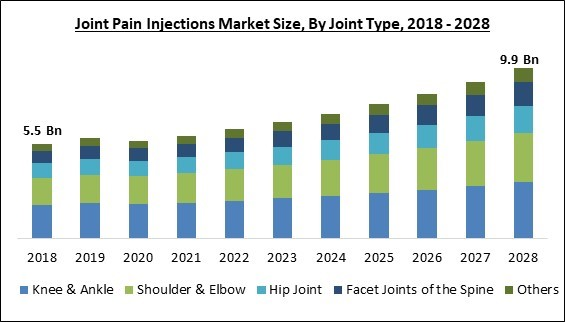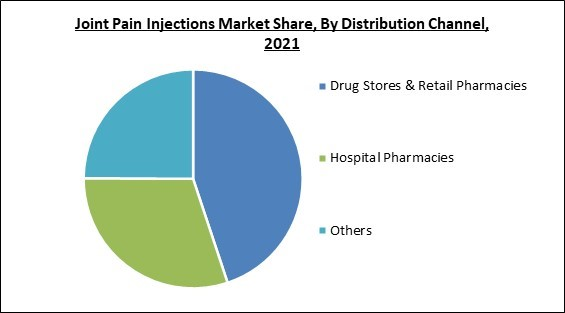The Global Joint Pain Injections Market size is expected to reach $9.9 billion by 2028, rising at a market growth of 7.7% CAGR during the forecast period.
Direct injections into the joints are used to treat joint pain and reduce swelling and inflammation. Geriatric patients typically have joint discomfort as a consequence of pre-existing medical conditions or illnesses. For example, joint pain from arthritis, a common condition that primarily affects the knee, ankle, hip, shoulder, elbow, and facet joints of the spine, causes inflammation and adds to joint discomfort. The market for joint pain injections is also anticipated to grow due to the rising prevalence of rheumatoid arthritis and osteoarthritis and the rising demand for economic therapies for these diseases.
The demand for joint pain treatment solutions is increased by the aging population and the rising prevalence of obesity. To meet this rising demand, the main market participants are doing research and development operations to produce more effective treatment options, such asprolotherapy, autologous conditioned serum, platelet-rich plasma,and plasma matrix therapy. Moreover, platelet-rich plasma (PRP) is created from the patient's blood and injected into a troublesome joint to reduce arthritis-related pain and stiffness. Furthermore, developing such cutting-edge procedures offers major market participants chances for investment, which is expected to fuel the market's expansion throughout the forecast period. In addition, the primary reason driving the expansion of the joint pain injections market is the rise in the frequency of accident-related injuries in modern society.
Increased R&D efforts by the major market players and innovations like single injection therapy and plasma matrix therapy will present profitable opportunities for the market players to invest. Other factors driving the growth of the joint pain injections market include the prevalence of obesity globally, the rise in geriatric patients, and the increase in the number of arthritis cases along with joint disorders. Nonetheless, physical therapy is frequently used with injections to preserve or increase joint stability and mobility. While physical therapy alone may not be sufficient to control pain &inflammation, the pairing typically produces superior benefits.
The market research report covers the analysis of key stake holders of the market. Key companies profiled in the report include Bioventus Inc., Pacira BioSciences, Inc., AbbVie, Inc., Teva Pharmaceuticals Industries Ltd., Pfizer, Inc., Anika Therapeutics, Inc., Zimmer Biomet Holdings, Inc., Eli Lilly And Company, Ferring Holdings SA, and Sanofi S.A.
Direct injections into the joints are used to treat joint pain and reduce swelling and inflammation. Geriatric patients typically have joint discomfort as a consequence of pre-existing medical conditions or illnesses. For example, joint pain from arthritis, a common condition that primarily affects the knee, ankle, hip, shoulder, elbow, and facet joints of the spine, causes inflammation and adds to joint discomfort. The market for joint pain injections is also anticipated to grow due to the rising prevalence of rheumatoid arthritis and osteoarthritis and the rising demand for economic therapies for these diseases.
The demand for joint pain treatment solutions is increased by the aging population and the rising prevalence of obesity. To meet this rising demand, the main market participants are doing research and development operations to produce more effective treatment options, such asprolotherapy, autologous conditioned serum, platelet-rich plasma,and plasma matrix therapy. Moreover, platelet-rich plasma (PRP) is created from the patient's blood and injected into a troublesome joint to reduce arthritis-related pain and stiffness. Furthermore, developing such cutting-edge procedures offers major market participants chances for investment, which is expected to fuel the market's expansion throughout the forecast period. In addition, the primary reason driving the expansion of the joint pain injections market is the rise in the frequency of accident-related injuries in modern society.
Increased R&D efforts by the major market players and innovations like single injection therapy and plasma matrix therapy will present profitable opportunities for the market players to invest. Other factors driving the growth of the joint pain injections market include the prevalence of obesity globally, the rise in geriatric patients, and the increase in the number of arthritis cases along with joint disorders. Nonetheless, physical therapy is frequently used with injections to preserve or increase joint stability and mobility. While physical therapy alone may not be sufficient to control pain &inflammation, the pairing typically produces superior benefits.
COVID-19 Impact Analysis
The population's lifestyle, use of other drugs, and other health-related behaviors have all changed due to the COVID-19 pandemic. Furthermore, COVID-19 noted a reduction in the sales of joint pain injections, which restrained the market's expansion throughout the pandemic. Due to a fall in hospital visits, the reallocation of healthcare resources, and the impact on the global supply chain, many major market participants reported a decline in their joint pain injection sector revenues.Market Growth Factors
Growing occurrence of osteoarthritis
Osteoarthritis is one of the leading causes of disability among the elderly and a prevalent illness (OA). As the population's average age rises, the incidence of knee osteoarthritis (OA) increases. OA is the leading cause of chronic disability and the most common articular disease in the industrialized world, with knee and/or hip OA being the most common form. As a result of population aging and the incidence of obesity andoverweight in the overall population, it is anticipated that the number of people with symptomatic knee OA will increase. Joint stiffness and pain may become severe enough to make ordinary tasks difficult. Due to the rising prevalence of osteoarthritis, it is anticipated that the market for injections to treat joint pain will undergo significant growth.Increasing global geriatric population
The World Health Organization predicts that by 2030, one in six people will be 60 or older. By this date, there will be 1.4 billion persons aged 60 or older, up from 1 billion in 2020. By 2050, the number of people worldwide aged 60 or older will have doubled. (2.1 billion). The number of persons aged 80 or older is anticipated to triple between 2020 and 2050, reaching 426 million. By 2050, two-thirds of the world's over-60 population will dwell in low- and middle-income countries. In the elderly, back and neck pain, osteoarthritis, COPD, diabetes, depression, and dementia are all frequent diseases. As people age, they are more likely to suffer from many ailments simultaneously. In light of this, the need for joint pain injections would increase dramatically over the forecast period due to the population's aging trend.Market Restraining Factors
Lack of knowledge regarding this treatment option
Injections for joint discomfort are unheard of by the general public. Joint soreness is treated with hyaluronic acid injections, corticosteroids, and platelet-rich plasma. It takes extensive knowledge and training to use these injections. Injections for joint pain are often given to patients by doctors and other medical personnel. Professionals are provided the equipment and instruction required to complete this. However, the market's expansion is constrained by the absence of government initiatives to support joint pain injections.Injection Type Outlook
Based on injection type, the joint pain injections market is segmented into interleukin inhibitors, hyaluronic acid injections and others. In 2021, the hyaluronic acid injections segment garnered a significant revenue share in the joint pain injections market. One of the main reasons influencing the hyaluronic acid injections segment is the growing desire for aesthetic beauty, which is fueled by the less intrusive nature of the treatments and the rising effectiveness of the injections. In addition, the growth of the hyaluronic acid injections market is being fueled by the introduction of new products and associated new indications and by more awareness of these injections in both developed and developing nations.Joint Type Outlook
On the basis of joint type, the joint pain injections market is classified into knee & ankle, hip joint, shoulder & elbow, facet joints of the spine, and others. In 2021, the knee & ankle segment witnessed the largest revenue share in the joint pain injections market. It is anticipated that the demand for intra-articular injections will rise in the near future due to the rising number of patients with osteoarthritis of the knee and ankle. Also, the market is expanding due to the rising number of patients receiving treatment and the diverse product portfolio provided by major players for treating knee osteoarthritis.Distribution Channel Outlook
By distribution channel, the joint pain injections market is categorized into hospital pharmacies, drug stores & retail pharmacies and online providers. The online segment covered a considerable revenue share in the joint pain injections market in 2021. The expansion of the segment is being driven by increased internet penetration in emerging nations. Also, the trend of digitalization has greatly aided the expansion of the online pharmacies. Further, due to the benefit of home delivery offered by these pharmacies, the segment is anticipated to witness significant growth.Regional Outlook
Region wise, the joint pain injections market is analysed across North America, Europe, Asia Pacific and LAMEA. In 2021, the North America region led the joint pain injections market with the maximum revenue share. This is brought on by the high incidence of musculoskeletal disorders, expanding senior population, strong market player presence in the area, improved healthcare infrastructure, public awareness of available technologies among stakeholders in the healthcare industry, and the region's high concentration of market players.The market research report covers the analysis of key stake holders of the market. Key companies profiled in the report include Bioventus Inc., Pacira BioSciences, Inc., AbbVie, Inc., Teva Pharmaceuticals Industries Ltd., Pfizer, Inc., Anika Therapeutics, Inc., Zimmer Biomet Holdings, Inc., Eli Lilly And Company, Ferring Holdings SA, and Sanofi S.A.
Scope of the Study
By Injection Type
- Interleukin Inhibitors
- Hyaluronic Acid Injections
- Others
By Distribution Channel
- Drug Stores & Retail Pharmacies
- Hospital Pharmacies
- Others
By Joint Type
- Knee & Ankle
- Shoulder & Elbow
- Hip Joint
- Facet Joints of the Spine
- Others
By Geography
- North America
- US
- Canada
- Mexico
- Rest of North America
- Europe
- Germany
- UK
- France
- Russia
- Spain
- Italy
- Rest of Europe
- Asia Pacific
- China
- Japan
- India
- South Korea
- Singapore
- Malaysia
- Rest of Asia Pacific
- LAMEA
- Brazil
- Argentina
- UAE
- Saudi Arabia
- South Africa
- Nigeria
- Rest of LAMEA
Key Market Players
List of Companies Profiled in the Report:
- Bioventus Inc.
- Pacira BioSciences, Inc.
- AbbVie, Inc.
- Teva Pharmaceuticals Industries Ltd.
- Pfizer, Inc.
- Anika Therapeutics, Inc.
- Zimmer Biomet Holdings, Inc.
- Eli Lilly And Company
- Ferring Holdings SA
- Sanofi S.A.
Unique Offerings
- Exhaustive coverage
- The highest number of Market tables and figures
- Subscription-based model available
- Guaranteed best price
- Assured post sales research support with 10% customization free
Table of Contents
Chapter 1. Market Scope & Methodology
Chapter 2. Market Overview
Chapter 3. Global Joint Pain Injections Market by Injection Type
Chapter 4. Global Joint Pain Injections Market by Distribution Channel
Chapter 5. Global Joint Pain Injections Market by Joint Type
Chapter 6. Global Joint Pain Injections Market by Region
Chapter 7. Company Profiles
Companies Mentioned
- Bioventus Inc.
- Pacira BioSciences, Inc.
- AbbVie, Inc.
- Teva Pharmaceuticals Industries Ltd.
- Pfizer, Inc.
- Anika Therapeutics, Inc.
- Zimmer Biomet Holdings, Inc.
- Eli Lilly And Company
- Ferring Holdings SA
- Sanofi S.A.










